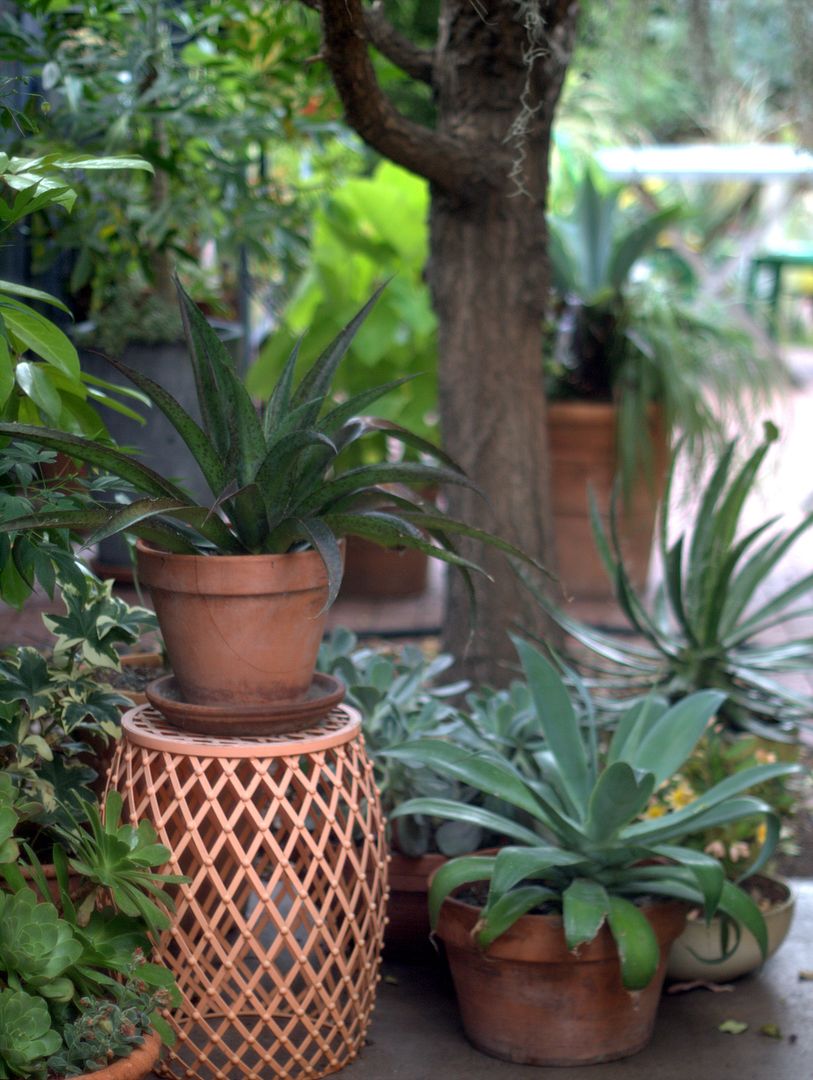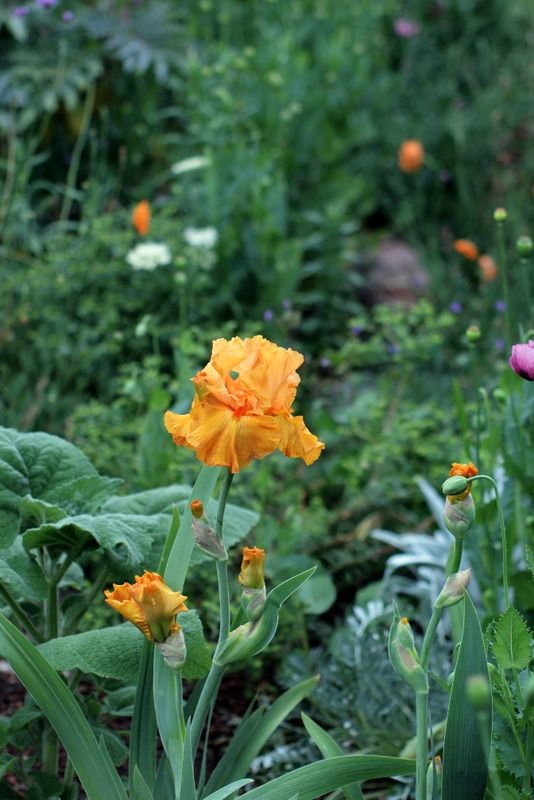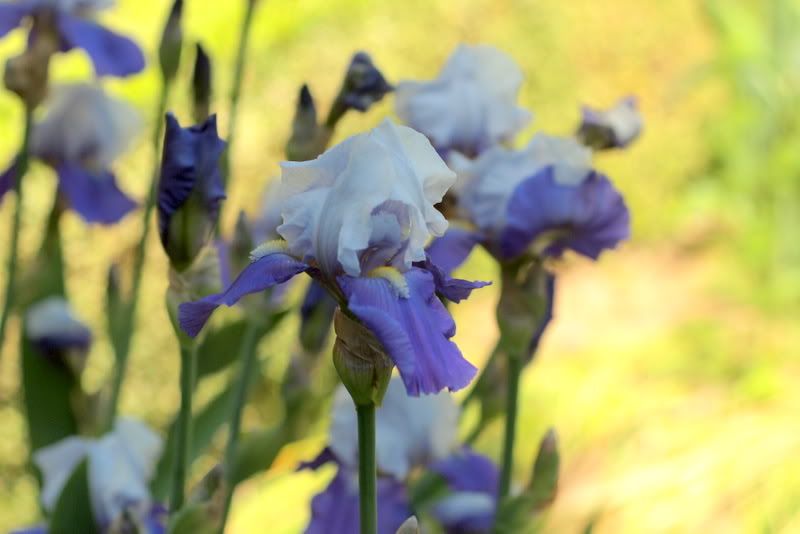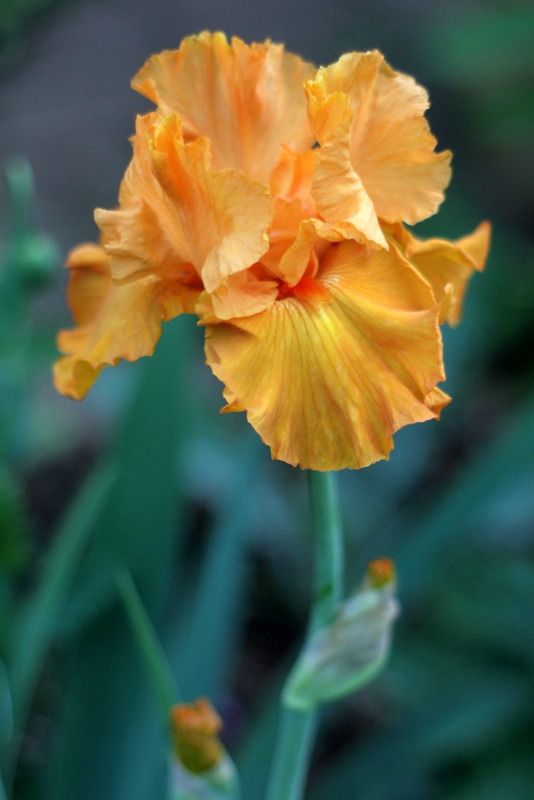Last week was a good one for plants. I finally found some Acacia ‘Cousin Itt’ in small sizes, under $10 each, to plant under the Chinese Fringe Tree. (Chionanthus retusus, as distinguished from our native Chionanthus virginicus.) This great, mediumish-sized tree grows in a rough square on the east side of the house, hemmed in by hardscape on all sides.

This photo from September 2015 shows how I typically mass pots on the hardscape surrounding the tree, which casts some welcome filtered shade for summer. Keeping the base unplanted has been the easiest way to go as far as cleaning up after the tree. (All the best things shed, i.e., trees, dogs, cats.) I just sweep the copious amounts of leaves/berries/spent flowers back under the tree and then raid the precious stuff when needed for mulch elsewhere in the garden. But then this vision of ‘Cousin Itt’ thriving in the dappled light of the fringe tree kept threatening to upend my pragmatic approach, and ultimately I just couldn’t shake it. I know, I’m weak that way. There’s too much constant debris for bromeliads to make sense under the tree, but I’m hoping I can gently rake through ‘Cousin Itt’ or give it a shake now and then.

One of the four new Acacias ‘Cousin Itt.’ I need at least three more. I’ve been wanting to try this acacia out for ages. It’s just not been available for under $40, so four for that price, even if in 6-inch pots, felt like the breakthrough I’ve been waiting for. Hurray for expensive plants in affordable sizes. It’s always fabulous in a container, but my vision required its green shagginess to ring the base of the tree. And there will still be access available for the broom to do its work. As with any planting in dry soil, you move the odds substantially in your favor by filling the planting hole several times with water before settling the plant into its new home.

These Celosia caracas ‘Scorching’ came home the same day as the acacias. I’ve been planting throughout summer, but wouldn’t consider putting these in the ground in August. They prefer steady moisture and rich soil, so I planted two in a big 5-gallon nursery can, where I can easily top them off with the hose. Oddly enough, I had just fired off an order to Annie’s Annuals & Perennials, and included in that order was another celosia, ‘Cramer’s Amazon.’ The order was mainly to get ahold of Rudbeckia triloba again. August is the best time to get biennials started, either from seed or plants if you can find them.

photo from Fernando Martos’ website. The bearded iris is ‘Syncopation’
Something else to order in August are bearded iris, a plant I’ve run hot/cold over for some years. Noel Kingsbury wrote about garden designer Fernando Martos‘ approach to Spanish gardens for Gardens Illustrated, July 2016: (“The typical Mediterranean garden is very static, it never changes. I want to make gardens that appear different every time you look at them.”)
I feel the same way. Summer wouldn’t be the same without transient poppies and spears and thistles surging skyward amidst the more permanent agaves and shrubs. Seeing how Martos dotted bearded iris throughout low-growing, dry garden shrubs like lavender had me checking iris suppliers online before finishing the article.


But be warned, it’s generally a very fleeting effect, a matter of weeks. Personally, I’m beginning to appreciate fleeting effects more and more. I last grew them in April of 2014. My style of overplanting tends to swamp their crowns, which require full sun to build up energy for the next year. But there’s no harm in trying again, is there?

Fleeting effects aside, when ordering bearded iris, I always get hung up on the issue of rebloom. There are a handful of varieties that are said to reliably rebloom in Southern California. The pink ‘Beverly Sills’ is one of them, and there’s more included in a list here. So it seems foolish not to order a potential, if not guaranteed, rebloomer, right? But the reblooming varieties are nowhere near as exciting as, for example, ‘Syncopation’ which blooms just once. I did find a couple bicolored varieties at Schreiner’s that supposedly rebloom. No guaranties. (‘Jurassic Park’ and ‘Final Episode’)

Something to add to your Things To Do in August list: If you care to have them next year, order bearded iris now!

Thanks for that.. I am ordering irises. They look really great in that prairie style planting.
Gaah, you have me wanting more Iris. They are a fleeting thing here with weather, borers, and overplanting. Love the ones you last planted. I went to the dwarf earlies a number of years ago and just had to move most of them as the nearby shrubs had overshadowed them. I agree that a static same view garden would become boring for most of us plant fiends. We live for the daily new surprise.
My ‘Cousin Itt’ have been happiest by far in the root-crowded soil under my peppermint willow and I hope yours will settle in just as well. I’m planning another go with bearded Iris myself. Repeated mulching covering up too much of the rhizomes was one of my errors but I think they also want regular water in winter as they’re growing. As nature have provided too little of that the last few years, I’m going to make it a point to water them by hand.
I’m so happy to hear you found a source for reasonably priced ‘Cousin Itt’. I swear, it’s in every garden I’ve visited lately. I’m more than eager to give it another try myself.
Love your ‘Cousin Itt’ and love a bargain-priced costly plant, too. Frankly (at least in my climate) smaller plants and shrubs root in and take off better and faster than larger plants. Beautiful bearded irises! One of my favorite scented flowers, but here in Ohio the borers are so bad and the plants so skunky-looking by mid-to-late summer that I find myself rethinking them each August, moving or removing. Plus they don’t play well with others in my garden when planted in close quarters, rolling over anything as the clump grows outward. Sigh.
What’s the cool spotted plant in the first photo, on the peach-colored drum? Manfreda? xMangave?
I’m a huge believer is constant seasonal change (surprise, surprise)…I like to always have something to look forward to 😉 Love Iris…love, love, love…but, like you, I have a crowded garden and they tend to get weaker every year…still, wouldn’t be without them!
@Jessica, I hope you read the comments. Lots of references to their less-than-stellar leaves after bloom. I’m hoping I can site these so that’s not so conspicuous!
@Cindy, I know! What a seesaw with bearded irises, but that photo was quite the propaganda for them.
@Kris, I was this close to linking to your blog. You have the best CI’s I’ve seen. So glad to hear root-crowded soil won’t be an issue.
@Gerhard, I noted them in your East Bay Garden Conservancy post. That garden is phenomenal.
@Tim, so true about smaller sizes getting a good root hold. So far borers haven’t been an issue for me. Yes, that’s a mangave Dustin spotted at a plant show.
@Scott, little incidents in the garden pull me through a long hot summer, but so hard fitting it all in!
I did read the comments and it’s definitely been an issue when I’ve grown them in the past. But that’s the beauty of growing them interspersed like this. The biggest problem, as someone rightly said, is creating too much shade for the rhizomes. But in the middle of a large, open planting such as the above I was hoping I could create little clearings for them where the leaves would still be less visible. I know, ever the optimist!
Ah, those stunning bearded beauties. In a former, much less crowded, garden I had some beauties. I’ve tried them again here but they’ve been crowded out. The ones you’ve shown are glorious!
Hi Denise. I check in to your website when I need a “beauty break” – thanks for your wonderful pictures and prose! I just thought I would chime in on bearded irises since I happen to work for a grower in Somis (Ventura County). Greenwood Daylily Gardens (www.greenwoodgarden.com) also grows bearded iris, including many reliable rebloomers in Southern California. Three of the best IMO (not mentioned in Karen Dardick’s article) are Frequent Flyer (pure white), Bernice’s Legacy (smokey red) and Grandma’s Purple Flag (dwarf dark purple). Frequent Flyer is blooming right now in my yard and Bernice’s Legacy was last week, along with Clarence. Maybe you might want to try those varieties?